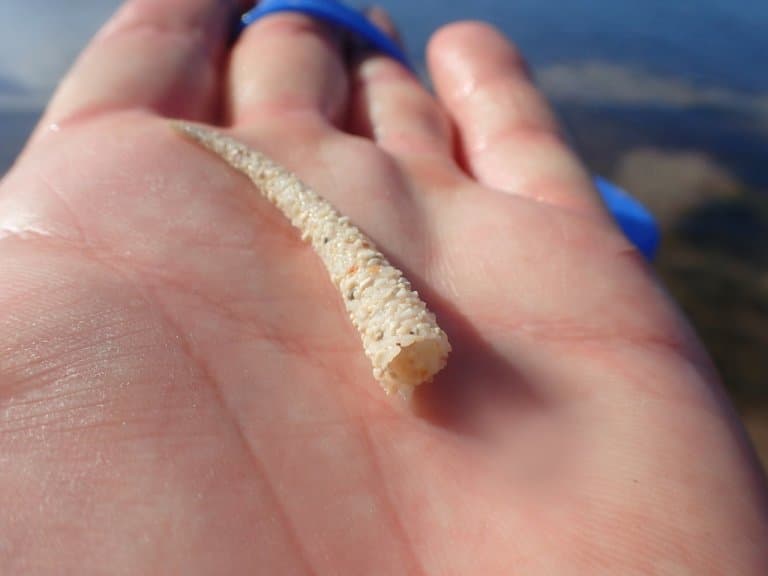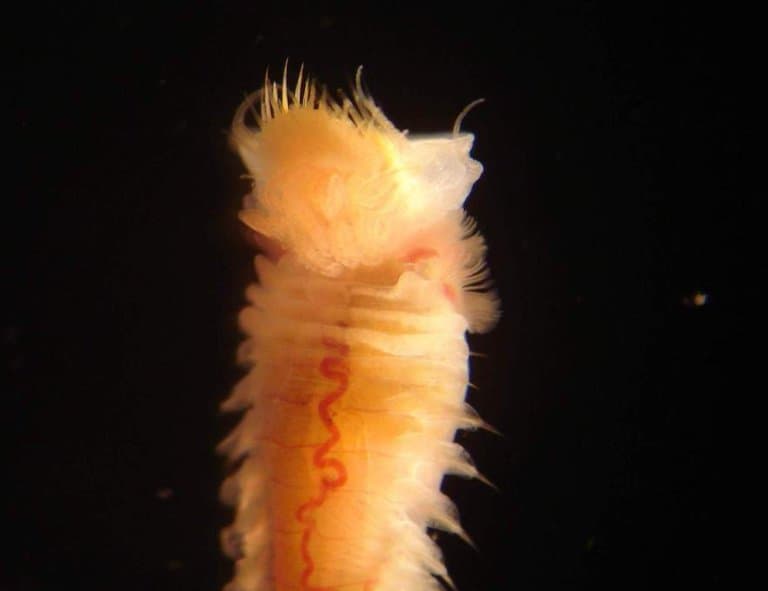Ice Cream Cone Worm Profile
If you forget to bring your ice cream to the beach this summer, you may not have to wait for the jingle of the van or head back into to town to find one.
Simply digging into the sand may uncover something just as tasty, or at least, far more interesting.
The ice cream cone worm, ‘trumpet worm’ or or pectinariidae, are a polychaete worm that live in the fine sediment of both shallow and deep seas, as well as the mud flats of estuaries and rivers.

Ice Cream Cone Worm Facts Overview
| Habitat: | Fine aquatic sediment, usually marine |
| Location: | Worldwide |
| Lifespan: | Unknown |
| Size: | Up to 10cm (4 inches) |
| Weight: | Unknown |
| Color: | Pale cream/grey |
| Diet: | Detritus, organic matter in the sediment |
| Predators: | Birds, crabs, fish |
| Top Speed: | They rarely move at all |
| No. of Species: |
50-140 |
| Conservation Status: |
Unknown |
They’re so-called only because of the shape of their shells, so it would be irresponsible of us to suggest you try eating one, though if you decide to, we would like to see the results.
They’re surprisingly hairy for ice cream, they make fake poo, and they might be more significant than they give themselves credit for. Here’s a look at one of the humblest animals in the ocean.
Interesting Ice Cream Worm Facts
1. They come in a cone
These worms are so-called not because they’re sweet and delicious to lick (that’s just a coincidence), but because they form a shell of grains, one-grain-thick, to protect them from the soft sediment they live in.
This shell is cone-shaped and is made by orienting sand grains, shell fragments and tiny stones, and attaching them with a special cement to the body of the worm.
It’s wide at the head end and tapers to a narrow hole at the other. Since the worm breathes through its skin, this shell helps keep its surfaces from getting clogged up in the fine sediment into which it burrows. 1
2. They’re hairy
These are annelids, like your common garden worm, but they’re a much fluffier version.
Like all polychaete worms, ice cream worms are covered in tufts of hair. They have them on their faces, on the sides of their segments, and even on their little arm-like gill protrusions.
They even have hairs, or bristles, on the posterior end, which is used to block the cone when they’re nervous.
The ones on their flanks help them latch into the substrate, allowing them to stay firm in their burrows.
The hairs on their faces are sensory and can pick up on their surroundings, burrow, and feed on the detritus found in the sediment. 2
3. They like to be face down in mud
The cone they build is wider at the head end, which is the end that sticks into the ground.
These worms don’t really move much at all once they’re in place, and spend their entire lives just face down, munching into the organic matter they find there.
And as you can imagine, this means they get a constant mouthful of sand and dirt as they burrow into the sediment. But they have a great way to deal with this!
4. Pseudofaeces
If it looks like poop and smells like poop, it still might not be poop. Some soft-bodied aquatic animals like the ice-cream worm have the need to expel various non-food items that are ingested when they dig their burrows.
Usually, this involves covering these particles in mucous and slipping them out when nobody’s looking. In the case of the ice cream worm, this means squeezing it between the animal’s body and the shell, or through the body, but outside of the gut.
This results in the production of something that is, according to a researcher with very peculiar life choices, “texturally indistinguishable from faeces”. 3
5. Facultatively mobile
You’d think that burying yourself face-first in mud would get kind of boring, but these worms like it so much that they barely ever move from their location. They don’t even have friends.
While capable of mobility, they rarely choose to use it. Instead, they stay put. When it comes to breeding, surprisingly little is known about their behaviour.

6. Lonely sex
It’s thought that there may be a release of pheromones into the water, attracting males to females, but they don’t need to get too close; for mating, both female and male sex cells are simply released into the water to mingle.
The larvae of these worms float around as plankton, eventually settling to cover themselves in mucous and stones, maturing in the sediment and repeating the cycle.
7. They like both deep and shallow waters
While most commonly found in muddy shallows, these worms are regularly brought up from the depths, too.
Problems arise in identifying them to the species level, but various familial traits are found in specimens plucked from depths of up to 270 meters confirmed, and a questionable claim of a record depth of 800m! 4
8. New species are being found all the time
While there isn’t a lot to report on these remarkably common worms (they don’t go out and do stuff to report on!), they are particularly prevalent, and as polychaetes, contribute to an extremely variable class of worms that live in all oceans, seemingly at all depths.
It’s hardly surprising, then, that there are new species being discovered seemingly every year. Two recent discoveries include a pair of species in China in 2017, and another in California, in late 2022.
How many species remain to be found is unknowable, but it does seem that such a widespread and diverse family of polychaete worms probably plays a significant role in the ecosystem.
Detritivores are the animals responsible for cleaning up all the poo and recycling nutrients back into the ecosystem, so while these little worms seem humble and relatively uninteresting, they’re probably one of the most important animals in the oceans! 5

Ice Cream Cone Worm Fact-File Summary
Scientific Classification
| Kingdom: | Animalia |
| Phylum: | Annelida |
| Clade: | Pleistoannelida |
| Subclass: | Sedentaria |
| Order: | Terebellida |
| Family: | Pectinariidae |
Fact Sources & References
- Tovar-Hernández MAA, de León-González JA (2022), “A new species of ice cream cone worm in the Gulf of California (Annelida, Pectinariidae)“, Biodiversity Data Journal.
- P AT H UTCHINGS AND R ACHAEL P EART (2010), “A Review of the Genera of Pectinariidae (Polychaeta) Together with a Description of the Australian Fauna“, Invertebrate Division, The Australian Museum.
- Fred C. Dobbs & Teresa A. Scholly (1986), “Sediment processing and selective feeding by Pectinaria koreni (Polychaeta: Pectinariidae)“, epartment of Genetics and Ecology, Aarhus University, Aarhus, Denmark.
- ZHANG, JINGHUAI; HUTCHINGS, PAT; KUPRIYANOVA, ELENA (2019), “A revision of the genus Petta Malmgren, 1866 (Annelida: Pectinariidae), with two new species from deep waters of southeastern Australia, and comments on phylogeny of the family“, Zootaxa.
- Zhang J, Qiu J-W (2017), “A new species of Pectinaria (Annelida, Pectinariidae), with a key to pectinariids from the South China Sea“, ZooKeys.
